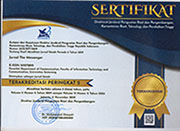Leadership Communication Conception of Malaysian Hindus and its Relevancy to Mahathir s Leadership
Abstract
Literatures proposed that culture does influence the success of leadership communication. Mahathir was criticised to be a leader who promotes the betterment of the majority community and marginalised the Indians. Despite of that, the Indians in Malaysia showed advancement in various sectors including politics, economy and social. Therefore, this exploratory study aims to bridge the gap by investigating the attributes that link between Mahathir s leadership communication and Indian community. Qualitative methodology was utilized and data were collected through a series of intensive interviews with 15 informants consists of Indian political, non-governmental organisation and community representatives. Based on the thematic analysis, two main attributes that strongly link to Indian culture were identified: leadership communication conception (Sattva Guna) and characteristics of good leadership communication (Sattva characteristics). This study has contributed to enhance understanding of leadership communication from multi-cultural context, specifically about the Indian s cultural conceptions.
Keywords
Full Text:
PDFReferences
Abu Bakar, H., & McCann, R. M. (2014). Matters of demographic similarity and dissimilarity in supervision-subordinate relationship and workplace attitudes. International Journal of Intercultural Relations, 14, 1 16.
Abuznaid, S. (2005). Islam and management: What can be learned? Thunderbird International Business Review, 48(1), 125 139.
Ahmad Atory, H. (1997). The Leadership Factor in Administrative Reform in Malaysia, with a Specific Study on the Leadership of Dr. Mahathir Mohamad, Prime Minister of Malaysia. Pertanika J. Soc. Sci. & Hum, 5(2), 103 123.
Amerson, R. (2011). Making a case for the case study method. Journal of Nursing Education, 50(8), 427 428. https://doi.org/10.3928.01484834-20110719-01
Andreouli, E. (2013). Identity and acculturation: The case of naturalized citizens in Britain. Culture & Psychology, 19(2), Cult. Psychol. https://doi.org/10.1177/1354067X13478984
Ardichvili, A., & Gasparishvili, A. (2001). Leadership profiles of managers in post-communist countries: A comparative study. Leadership & Organization Development Journal, 22(2), 62 69.
Asma, A. (1992). The influence of ethnic values on managerial practices in Malaysia. Malaysian Management Review, 27(1), 3 15.
Asma, A., & Lim, L. (2001). Cultural dimension of Anglos, Australians and Malaysians. Malaysian Management Review, 36(2), 1 17.
Asma, A., & Singh, S. (1992). Leading and motivating. In In A. Asma (Eds.) Understanding Malaysian workforce: Guideline for managers (pp. 33 48). Kuala Lumpur: Malaysian Institute of Management.
Ayman, R., & Korabik, K. (2010). Leadership: Why gender and culture matter. American Psychologist, 65, 157 170.
Baharuddin, S. A. (2005). Making sense of national unity in Malaysia: Break down versus break out perspective. Kuala Lumpur: COLLA Research Group.
Bakar, H. A., Jian, G., & Fairhurst, G. (2014). Where do I stand? The interaction of leader-member exchange and performance ratings. Asian Business & Management, 13(2), 143 170.
Barrett, D. (2014). Leadership communication (4th ed.). New York: McGraw-Hill Education.
Bass, B. M. (1990). Bass & Stogdill s handbook of leadership (3rd ed.). New York: Free Press.
Bass, B. M. (1997). Does the transactional-transformational leadership paradigm transcend organizational and national boundaries? American Psychologist, 52(2), 130 139.
Bass, B. M. (1999). Two decades of research and development in transformational leadership. European Journal of Work and Organizational Pyschology, 8(9 32).
Bass, B. M., & Avolio, B. J. (1994). Improving organizational effectiveness through transformational leadership. Thousand Oaks: Sage.
Beekun, R. I., & Badawi, J. A. (2005). Balancing ethical responsibility among multiple organizational stakeholders: The Islamic perspective. Journal of Business Ethics, 60, 131 145.
Bernard, R. H. (2012). Social research methods: Qualitative and quantitative approaches (2nd ed.). Thousand Oaks: Sage.
Beyer, J. M. (1999). Taming and promoting charisma to change organizations. Leadership Quarterly, 10(2), 307 30.
Bhopal, M., & Rowley, C. (2005). Ethnicity and a management issue and resources: Examples from Malaysia. Asia Pacific Business Review, 11(4), 553 574.
Bucic, T., Robinson, L., & Ramburuth, P. (2010). Effects of leadership style on team learning. Journal of Workplace Learning, 22(4), 228 248. https://doi.org/10.1108/13665621011040680
Burns, J. M. (1978). Leadership. New York: Harper & Row.
Chemers, M. M., & Ayman, R. (1993). Leadership theory and research: Perspectives and directions. San Diego: Academic Press.
Chen, C. C., & Van Velsor, E. (1996). New directions for research and practices in diversity leadership. Leadership Quarterly, 7(2), 285 302.
Chinmayanda, S. (2003). The Holy Geeta. Mumbai: Central Chinmaya Mission Trust.
Choong, L., & Thomas, D. C. (1997). Leadership perceptions in the cross-cultural context: Pakeha and Pacific Islanders in New Zealand. Leadership Quarterly, 8(3), 275 293.
Dahles, H., & Leng, L. W. (2014). Multicultural Organizations in Asia. Taylor & Francis. https://doi.org/10.4324/9781315874159
Dahlia, Z. (2008). Cultural dimension among Malaysian employees. International Journal of Economics and Management, 2(2), 479 490.
Davis, R. H. (2014). The Bhagavad-Gita : A biography. Princeton University Press.
Engardio, P., & McGregor., J. (2006, October 30). Karma capitalism. Business Week.
Ensaria, N., & Murphy, S. E. (1999). Cross-cultural variations in leadership perceptions and attribution of charisma to the leader. Organizational Behavior and Human Decision Processes, 92, 52 66. https://doi.org/10.1016/S0749-5978(03)00066-9.
Ergeneli, A., Gohar, R., & Temirbekova, Z. (2007). Transformational leadership: Its relationship to culture value dimensions. International Journal of Intercultural Relations, 31(6), 703 724. https://doi.org/10.1016/j.ijintrel.2007.07.003
Fairhurst, G. T., & Connaughton, S. L. (2014). Leadership: A communicative perspective. Leadership, 10(1), 7 35. Retrieved from http://dx.doi.org/10.1177/1742715013509396
Gardenswartz, L., Rowe, A., Digh, P., & Bennett, B. (2003). The global diversity desk reference: Managing an international workforce. Somerset: Wiley Publishers.
Gordon, A., & Yukl, G. (2004). The future of leadership research: Challenges and opportunities. German Journal of Human Resource Management, 18(3), 359 365. Retrieved from https://www.gitasupersite.iitk.ac.in/srimad?ecsiva=1&choose=1&&language=ta&field_chapter_value=17&field_nsutra_value=18
Graen, G. B. (2006). In the eye of the beholder: cross-cultural lesson in leadership from project GLOBE: A response viewed from the third culture bonding (TCB) model of cross-cultural leadership. The Academy of Management Perspective, 20(4), 95 101.
Gudykunst, W. B., & Nishida, T. (2001). Anxiety, uncertainty, and perceived effectiveness of communication across relationships and cultures. International Journal of Intercultural Relations, 25(1), 55 71.
Hall, R. J., & Lord, R. G. (1995). Multi-level information processing explanations of followers leadership perceptions. Leadership Quarterly, 6, 265 287. Retrieved from https://www.gitasupersite.iitk.ac.in/srimad?ecsiva=1&choose=1&&language=ta&field_chapter_value=17&field_nsutra_value=18
Hofstede, G. (1980). Motivation, leadership, and organization: Do American theories apply abroad? Organizational Dynamics, 9(1), 42 63. https://doi.org/10.1016/0090-2616(80)90013-3
Hofstede, G. (1983). National cultures in four dimensions: A research-based theory of cultural differences among nations. International Studies of Management & Organizations, 13(1 2), 46 74.
Hofstede, G. (1991). Empirical models of cultural differences. Lisse: Swets & Zeitlinger.
Hofstede, G. (2001). Culture s consequences: Comparing values, behaviors, institutions, and organizations across cultures. Thousand Oaks: Sage.
Hofstede, G., & Hofstede, G. J. (2005). Cultures and organizations: Software of the mind (2nd ed.). New York: McGraw-Hill USA.
Hofstede, G., & Minkov, M. (2010). Long-versus short-term orientation: New perspective. Asia Pacific Business Review, 16(4), 493 504.
House, R., & Aditya, R. (1997). The social scientific study of leadership: Quo vadis? Journal of Management, 23(3), 409-474.
Jung, D., & Avolio, B. (1999). Effects of leadership style and followers cultural values on performance under different task structure conditions. Academy of Management Journal, 42, 208 218. https://doi.org/10.2307/257093
Kailasam, A. (2015). Indian identity and nation building in Malaysia. Kajian Malaysia, 33(1), 1 18. Retrieved from http://web.usm.my/km/33(1)2015/km33012015_01.pdf
Kanungo, R. N., & Misra, S. (2004). Motivation, leadership, and human performance. In J. Pandey (Ed.). Psychology in India Revisited: Developments in the Discipline, 3, 309 341.
Kejriwal, A., & Krishnan, V. R. (2004). The impact of Vedic worldview and Gunas on transformational leadership. Vikalpa, 29(1), 29 40.
Kennedy, J. C. (2002). Leadership in Malaysia: Traditional values, international outlook. Academy of Management Executive, 16(3), 15 25.
Khandwalla, P. N. (1990). Strategic developmental organizations: Some behavioural properties. In A. M. Jaeger & R. N. Kanungo (Eds.), Management in developing countries (pp. 275 286). London: Routledge.
Krishnan, V. R. (2002). No TitleTransformational leadership and value system congruence. International Journal of Value-Based Management, 15(1), 19 33.
Leslie, J. B., & Van Velsor, E. (1998). A cross national comparison of effective leadership and teamwork toward a specific global workforce. North Carolina: Center for creative leadership.
Lord, R. G., Brown, D. J., & Freiberg, S. J. (1999). Understanding the dynamics of leadership: The role of follower self-concepts in the leader/follower relationship. Organizational Behavior and Human Decision Process, 78, 167 203.
Lynn-Sze, & Ahmad, M. K. (2017). Confucian value-based leadership communication: A study on Tun Dr. Mahathir Mohamad. Malaysian Journal of Communication, 33(3), 140 156.
Lynn-Sze, J. C., Yusof, N., & Ahmad, M. K. (2014). The relevance of Confucian values to Leadership communication. Malaysian Journal of Communication, 30, 129 144.
Markus, H. R., & Kitayama, S. (1991). Culture and the self: Implications for cognition, emotion, and motivation. Psychological Review, 224 253.
Means, G. P. (1991). Malaysian Politics: The Second Generation. Singapore: Oxford University Press.
Mhatre, K. H., & Riggio, R. E. (2014). Charismatic and transformational leadership: present, and future. In The Oxford Handbook of Leadership and Organizations (pp. 221 240).
Mohd. Yusoff, Z. H., Roselina, A. S., & Syed Azizi, W. (2002). No TLeadership style preferences of Malaysian managersitle. Malaysian Management Review, 37(1).
Muniapan, B. (2006). Can the Bhagavad-Gita be used as a manual for management development of Indian managers worldwide? In Asian Management: Convergence and Divergence. Tokyo: 5th Asia Academy of Management Conference.
Muniapan, B. (2007). Transformational leadership style demonstrated by Sri Rama in Valmiki Ramayana. International Journal of Indian Culture and Business Management, 1(1), 104 115.
Panda, A., & Gupta, R. K. (2007). Call for developing indigenous organizational theories in India: Setting agenda for future. International Journal of Indian Culture and Business Management, 1(1/2), 205 243.
Paramita, S., & Carissa, R. M. (2018). Inter-ethnic communication barriers in Pontianak City. Jurnal The Messenger, 10(1), 54 62.
Paramova, P., & Blumberg, H. (2017). Cross cultural variation in political leadership styles. Europe s Journal of Psychology, 13(4), 749 766. https://doi.org/10.5964/ejop.v13i4.1412
Patton, M. Q. (2002). Qualitative research and evaluation methods (3rd ed.). Thousand Oaks: Sage.
PaulienÄ—, R. (2012). Transforming leadership styles and knowledge sharing in a multicultural context. Transforming Leadership Styles and Knowledge Sharing in a Multicultural Context, 10(1), 91-109. https://doi.org/10.3846/bme.2012.08
Rarick, C. A., & Nickerson, I. (2008). Expanding managerial consciousness: Leadership advice from the Bhagavad-Gita. Proceedings of the Academy of Organizational Culture, Communications and Conflict, 13(1).
Rusdi, O., & Sivamurugan, P. (2006). Falsafah Pemikiran Politik Dr. Mahathir Mohamad. Pulau Pinang: Universiti Sains Malaysia.
Saad, S. (2012). Re-building the Concept of Nation Building in Malaysia. Science, 8(4), 115 123. https://doi.org/10.5539/ass.v8n4p115
Simbolon, D. (2012). Memahami komunikasi beda budaya antara suku Batak Toba dengan Suku Jawa di Kota Semarang (studi pada mahasiswa Suku Batak Toba dengen Suku Jawa di Universitas Semarang). Jurnal The Messenger, 4(1), 43 49.
Singh, N., & Krishnan, V. R. (2007). Transformational leadership in India: Developing and validating a new scale using Grounded Theory approach. International Journal of Cross Cultural Management, 7(2), 219 236. https://doi.org/10.1177/1470595807079861
Singh, P., & Bhandarker, A. (1990). Corporate success and Transformational Leadership. New Delhi: Wiley Eastern.
Sinha, A. K., & Kaur, P. (1992). Dimension of Guna in Organizational Setting. Sage Journals, 17(3).
Smith, P. B., & Peterson, M. F. (2002). Cross-cultural leadership. In M. J. Gannon & L. K. Newman (Eds.), The Blackwell handbook of cross-cultural management (pp. 217 235). Oxford: Blackwell Publishers Ltd.
Taman, E., & Krauss, S. E. (2017). Ethnic-related diversity engagement differences in intercultural sensitivity among Malaysian undergraduate students. International Journal of Adolesence and Youth, 22(2), 137-150.
Tayeb, M. (1997). Islamic revival in Asia and human resource management. Journal of Employee Relations, 19(4), 352 364.
Thomas, J., & Harden, A. (2008). Methods for the thematic synthesis of qualitative research in systematic reviews. BMC Med Res Meth, 8, 45.
Tichy, N. M., & DeVanna, M. A. (1990). The transformational leader. New York: Wiley.
Van Knippenberg, D., & Sitkin, S. B. (2013). A critical assessment of charismatic-transformational leadership research: Back to the drawing board? The Academy of Management Annals, 7(1), 1 60.
Wain, B. (2012). Malaysian maverick: Mahathir Mohamad in turbulent times. Journal of Social Issues in Southeast Asia, 20(1), 156 160. https://doi.org/10.1355/sj28-1g
Wibbeke, E. S. (2010). Global Business Leadership. Taylor & Francis.
Yukl, G. (2006). Leadership in organizations (6th ed.). Englewood Cliffs, NJ: Prentice-Hall.
DOI: http://dx.doi.org/10.26623/themessenger.v11i1A.827
Refbacks
- There are currently no refbacks.
Copyright (c) 2019 Jurnal The Messenger
View My Stats [Jurnal The Messenger] is an International Scientific Journal, Published by the Department of Communication, Faculty of Information Technology and Communication, Universitas Semarang (Central Java, Indonesia). It is licensed under a Creative Commons Attribution 4.0 International License.



_11.jpg)




_BARCODE.jpg)
_BARCODE1.jpg)


5.png)










2.png)





